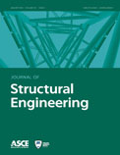
JOURNAL OF STRUCTURAL ENGINEERING
Scope & Guideline
Charting New Frontiers in Structural Research
Introduction
Aims and Scopes
- Structural Safety and Performance:
The journal explores the safety and performance of structural systems under various loading conditions, including seismic, wind, and fire. Research often includes experimental studies and numerical simulations to evaluate and enhance the resilience of structures. - Material Innovation and Sustainability:
A significant focus is placed on the development and optimization of new materials, such as fiber-reinforced concrete and geopolymer composites, to promote sustainability in construction practices. Studies often investigate the mechanical properties and durability of these materials. - Advanced Analytical and Numerical Methods:
The journal showcases research utilizing advanced analytical techniques and numerical modeling, including finite element analysis and machine learning approaches, to predict structural behavior and assess performance under different conditions. - Structural Rehabilitation and Retrofitting:
Research on techniques for the rehabilitation and retrofitting of existing structures to improve their performance and extend their service life is a key area of interest. This includes studies on innovative strengthening methods and materials. - Geotechnical and Infrastructure Engineering:
The journal also addresses the interaction between structural and geotechnical engineering, focusing on the performance of foundations, retaining structures, and the impact of environmental factors on structural integrity.
Trending and Emerging
- Resilience and Disaster Mitigation:
There is an increasing emphasis on resilience in structural design, particularly in response to natural disasters such as earthquakes and floods. Research is focusing on innovative design strategies and materials that enhance the ability of structures to withstand extreme events. - Smart Structures and Monitoring:
The integration of smart technologies for real-time monitoring and assessment of structural health is emerging as a significant theme. This includes the use of sensors, data analytics, and machine learning to predict structural performance and maintenance needs. - Sustainable and Green Construction Practices:
Research exploring sustainable construction methods and materials, including the use of recycled materials and waste in concrete production, is on the rise. This reflects a broader trend towards environmental responsibility in engineering practices. - Performance-Based Design Approaches:
There is a growing trend towards performance-based design methodologies, which focus on meeting specific performance criteria rather than adhering strictly to prescriptive codes. This approach allows for more innovative and efficient structural solutions. - Behavior of Novel Composite Materials:
Studies investigating the behavior and applications of novel composite materials, such as fiber-reinforced polymers and geopolymer concrete, are gaining momentum. This reflects a shift towards exploring advanced materials for enhanced structural performance.
Declining or Waning
- Traditional Construction Materials:
There has been a noticeable decrease in the publication of studies focused solely on traditional construction materials, such as standard concrete and steel. This shift indicates a growing interest in alternative materials and sustainable practices. - Basic Structural Analysis Techniques:
Research centered on classical structural analysis methods, such as basic static and dynamic analysis without advanced computational techniques, has seen a decline. This suggests a move towards more sophisticated modeling approaches that incorporate modern technology. - Generalized Structural Design Codes:
Papers focusing on the application of generalized design codes without critical evaluation or innovation are becoming less frequent. The journal now emphasizes more on specific case studies and innovative design methodologies.
Similar Journals
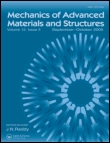
MECHANICS OF ADVANCED MATERIALS AND STRUCTURES
Illuminating the mechanics behind advanced materials and structures.Mechanics of Advanced Materials and Structures is a distinguished journal published by Taylor & Francis Inc, focusing on the innovative fields of Civil and Structural Engineering, Materials Science, Mechanical Engineering, and Mechanics of Materials. With ISSN 1537-6494 and E-ISSN 1537-6532, this journal is positioned within the Q2 quartile rankings of its categories, demonstrating its significant scholarly impact. It has been a pivotal platform since its inception in 1997, providing researchers and professionals with comprehensive insights and the latest findings, until the expected closure in 2024. Situated in the United Kingdom, the journal is dedicated to enhancing the understanding of complex materials and structural behavior through rigorous peer-reviewed articles. Its high visibility in Scopus rankings further underscores its importance, making it an essential resource for those engaged in advanced materials research and structural analysis. With options for open access, the journal ensures broad dissemination of knowledge, fostering a collaborative environment for researchers, practitioners, and students alike.

Journal of Structural Integrity and Maintenance
Championing Knowledge for Safer, More Efficient StructuresThe Journal of Structural Integrity and Maintenance, published by Taylor & Francis Ltd, serves as a prestigious platform dedicated to the advancement of knowledge in the fields of structural integrity, civil engineering, and materials science. With an ISSN of 2470-5314 and an E-ISSN of 2470-5322, this journal is uniquely positioned to address the critical challenges faced by researchers and professionals in building and construction, mechanical engineering, and related domains. Since its inception in 2016, this journal has been consistently recognized for its quality, currently holding a Q2 rank across several disciplines, including Building and Construction and Civil and Structural Engineering in 2023. The journal aims to publish high-quality research that contributes to the understanding and maintenance of structural integrity, fostering innovations that promote safety, efficiency, and sustainability in engineering practices. Researchers and students alike are encouraged to engage with this rich repository of knowledge, which plays a vital role in shaping future advancements in structural engineering and materials science.

International Journal of GEOMATE
Advancing sustainable engineering practices through innovative research.The International Journal of GEOMATE, published by GEOMATE INT SOC based in Japan, is a pivotal resource for scholars and practitioners in the fields of Building and Construction, Environmental Engineering, Geotechnical Engineering, and Soil Science. Established in 2011 and continuing to set the standard in its focus areas, this journal serves as a platform for innovative research and practical applications, with contributions that significantly enhance the understanding and development of sustainable engineering practices. With its current classification in the Q3 quartile across multiple categories, it strives to disseminate critical knowledge and foster dialogue among a diverse audience, including researchers, industry professionals, and students. Though operating under a traditional subscription model, the journal's emphasis on rigorous peer review and high-quality publications ensures a substantial impact factor, further reinforcing its reputation in academia. Spanning from 2011 to 2024, the International Journal of GEOMATE invites contributions that advance the knowledge frontier and address contemporary challenges in engineering and environmental science.

Revista Ingenieria de Construccion
Exploring the Intersection of Theory and Practice in ConstructionRevista Ingenieria de Construccion is a prominent open-access journal dedicated to advancing knowledge and practice in the fields of building and construction engineering, as well as civil and structural engineering. Published by the Pontificia Universidad Católica de Chile, specifically the Department of Engineering and Construction Management, this journal has been providing free access to quality research outputs since 1986, ensuring that vital information is available to both practitioners and academics globally. With its current placement in the Q4 category of both the Building and Construction and Civil and Structural Engineering quartiles, it serves as a platform for innovative studies and critical discussions, positioning itself strategically within the academic landscape. The journal is indexed in Scopus, ranking #157 in Building and Construction and #291 in Civil and Structural Engineering, reflecting the growing impact and relevance of its contributions. Researchers, professionals, and students are encouraged to engage with the rigorous and diverse content published within its pages, fostering a vibrant academic and practical discourse.
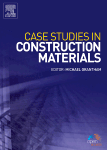
Case Studies in Construction Materials
Elevating Industry Standards through Scholarly InsightsCase Studies in Construction Materials, an esteemed journal published by Elsevier, provides a vital platform for the dissemination of scholarly research in the field of materials science, focusing particularly on innovations and advancements in construction materials. With its Q1 ranking in the 2023 Scopus category of Materials Science (Miscellaneous), the journal stands out for its high-impact contributions and commitment to enhancing industry practices. Open Access since 2014, Case Studies in Construction Materials promotes wide accessibility and engagement, encouraging collaborations among researchers, professionals, and students globally. Whether delving into innovative methodologies, sustainability in construction materials, or case studies that exemplify best practices, this journal is crucial for those seeking to advance the science and application of construction materials. Located in Amsterdam, Netherlands, its robust publication history from 2014 to 2024 ensures it remains a leading resource for contemporary research and academic exploration.
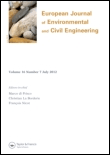
European Journal of Environmental and Civil Engineering
Exploring Interdisciplinary Approaches to Environmental ChallengesThe European Journal of Environmental and Civil Engineering, published by Taylor & Francis Ltd, is a prestigious peer-reviewed journal that serves as a vital platform for advancing knowledge in the fields of Civil and Structural Engineering as well as Environmental Engineering. With an impressive impact factor and categorized in the Q2 quartile for both engineering fields, this journal occupies a significant position in the scholarly community. Its focused scope encompasses innovative research, case studies, and practical applications that address contemporary environmental and infrastructural challenges. Researchers, professionals, and students alike benefit from the journal's commitment to high-quality discourse, as evidenced by its Scopus rankings, which place it in the top 30% in Civil and Structural Engineering and the top 40% in Environmental Engineering. Through the publication of cutting-edge studies and a commitment to fostering interdisciplinary dialogue, the European Journal of Environmental and Civil Engineering remains an essential resource for those dedicated to improving our built environment and safeguarding our natural resources.

STRUCTURAL ENGINEERING AND MECHANICS
Elevating Standards in Civil and Mechanical EngineeringSTRUCTURAL ENGINEERING AND MECHANICS, a leading journal published by TECHNO-PRESS, stands at the forefront of research in the disciplines of civil, structural, and mechanical engineering. With an ISSN of 1225-4568 and an E-ISSN of 1598-6217, this South Korea-based journal has been a significant contributor to the academic community since its inception in 1994, and it continues to disseminate vital research through 2024 and beyond. Achieving a Q3 ranking in key categories such as Building and Construction, Civil and Structural Engineering, Mechanical Engineering, and Mechanics of Materials, the journal is recognized for its high standard of academic rigour and relevance in contemporary engineering challenges. Although not Open Access, it offers robust access options for institutions and professionals seeking to advance their understanding of structural systems and mechanics. Researchers, students, and practitioners in these fields will find invaluable insights and innovative studies that push the boundaries of knowledge, making this journal an essential resource for anyone invested in engineering advancements.

Revista de la Construccion
Advancing Civil Engineering Knowledge for a Sustainable FutureRevista de la Construcción is a pivotal academic journal dedicated to the field of civil engineering and construction, published by the prestigious Pontificia Universidad Católica de Chile, Escuela de Construcción Civil. With its ISSN 0718-915X, this journal serves as a crucial platform for disseminating innovative research, case studies, and advancements in construction methodologies that address contemporary challenges within the industry. While currently not classified as open access, it provides valuable insights benefiting researchers, professionals, and students engaged in construction development and sustainability. The journal enhances the academic discourse and contributes significantly to knowledge in engineering practices, project management, and material science. Based in Santiago, Chile, the journal aims to foster collaboration and knowledge exchange among experts both locally and globally, making it an essential resource for those striving to advance the science and practice of construction.

Journal of Constructional Steel Research
Shaping Tomorrow’s Infrastructure with Steel InsightsJournal of Constructional Steel Research, published by Elsevier Ltd, stands as a leading platform in the realm of constructional steel research since its inception in 1980. With a robust focus on Building and Construction, Civil and Structural Engineering, Mechanics of Materials, and Metals and Alloys, this prestigious journal has earned its place in the Q1 category across multiple disciplines, symbolizing excellence in scholarly contributions. The journal's impressive Scopus rankings further underscore its significance, ranking 30th out of 223 in Building and Construction, and exhibiting strong standings in other related fields. Researchers, professionals, and students will find this publication an invaluable resource, offering access to the latest findings and innovations in constructional steel, necessary for advancing practices in engineering and material sciences. Although it does not operate under an open-access model, the content is meticulously curated to ensure high-quality, peer-reviewed research, continuing to shape the future of steel construction methodologies.
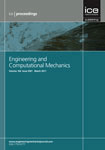
Proceedings of the Institution of Civil Engineers-Engineering and Computational Mechanics
Advancing the Frontiers of Civil Engineering and MechanicsProceedings of the Institution of Civil Engineers - Engineering and Computational Mechanics is a prestigious journal published by Emerald Group Publishing Ltd, dedicated to advancing the fields of civil and structural engineering, as well as mechanics of materials. With an ISSN of 1755-0777 and E-ISSN 1755-0785, this journal serves as a critical platform for disseminating innovative research and practical insights from 2009 through 2024. As part of its commitment to academic rigor, it is categorized in the Q4 quartile for both civil and structural engineering and mechanics of materials, reflecting a unique position in the scholarly community. The journal is essential for professionals, researchers, and students aiming to stay informed on current trends, methodologies, and applications in engineering and computational mechanics. By engaging with this publication, readers gain access to crucial findings that contribute to the advancement of infrastructure and materials science, vital for developing resilient and sustainable engineering solutions.